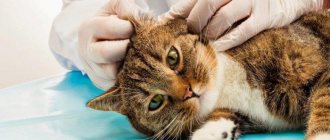People have long had special feelings for cats. It is these graceful creatures that bring many pleasant moments to a person. A cat can become not only a source of positive emotions, but also a sign of status if the animal is an elite breed and costs a lot of money. Kittens are also presented as expensive gifts.
Therefore, cat breeding often becomes a profitable business. But to do it, you will first need to study a lot of useful information about cat breeding. This article is devoted to this issue.
Puberty of cats
Cats enter sexual maturity at the age of 8 months. At this time, they tend to leave home, mark themselves everywhere, “attack” inanimate objects (soft toys, sofa thoughts, etc.), and become aggressive and irritable.
If a cat in heat appears within the cat's reach, the male becomes highly excited.
Experts recommend carrying out the first mating of a male with a female who has already given birth. It is highly not recommended to bring two virgin felines together. Breeding cats are bred first 1-2 times a month, and then 1-2 times a week.
Why do cats scream during mating?
It takes a cat a few seconds to impregnate his partner. At this time, the cat firmly grabs the female by the withers with his teeth, without letting her go. Sexual intercourse often ends tragically for the male.
The embittered female partner screams loudly, tries to wriggle out and bite her lover on the throat, the reason is that during the mating process the female feels severe pain. As a rule, it is the cat who cries during intercourse because of painful intercourse.
The thing is that there are hard scales on the partner’s genitals that are prickly to the touch. The process of fertilization takes place as follows: the male genital organ penetrates the vagina, reaches the uterus, and is fixed there with the help of scales, which cause severe pain.
Puberty
Cats reach sexual maturity at the age of 5-9 months. They try to attract attention to themselves, rub against objects, lie on their backs, meow piercingly, ask for freedom, leave marks, and lose their appetite.
The frequency of estrus in cats can vary and depends on the conditions of detention. It usually occurs in winter, in January-February and lasts several days. And then the heat goes away in the summer and can last up to two weeks. However, these dates are approximate. Cats remain fertile throughout their lives. There are cases where females at the age of 20 gave birth to offspring.
Physiological features
In cats, like other animals, hormones influence sexual behavior. Physiological processes are characterized by cyclicity:
- The passive breeding period of cats (anaestrus) is associated with the length of daylight hours and lasts about 4 months. During the year, moments of sexual activity occur 2-3 times.
- The stage of preparation for mating is called proestrus. At this time, the cat becomes affectionate and excited, but does not allow the cat to approach her. Her vulva is swollen, although there is no discharge. The phase lasts 1-3 days.
- The period of estrus is readiness for mating. The cat purrs, meows, rolls on the floor. When stroking, it stands in a position of readiness for mating and withdraws its tail. At this time, she begins to have discharge and has no appetite. The cat may run away from the house.
The entire period of estrus can last a long time and even continuously. The smell of such females attracts cats, and they start fights. Let's look at how reproduction occurs in cats below.
The nuances of the first mating of cats at home
During the first mating, a domestic cat shows aggression and is capable of injuring its partner.
Animal owners should take into account a number of nuances in advance so that the mating is successful and the pet is not harmed:
- Mating should be done in the male's territory, this gives more chances for successful conception.
- Initially, the female should be left in a separate room so that the furry predator calms down and masters the new territory.
- You should have a carrier bag on hand in which you can lock an angry cat if the process does not go according to plan.
- For the first mating, animals should be selected so that one of the partners already has experience of intercourse.
- The cat's estrus at the time of mating should be in the most active phase (the first 2-3 days from the beginning of estrus).
Mating rules
In nature, a cat can choose a partner for reproduction. But when breeding at home, it is worth using the services of special clubs. At the same time, it is important not to bring close relatives together. Mating of unrelated individuals allows you to introduce new characteristics into the breed.
Breeders believe that when breeding cats at home, it is better to bring a female to a male, and not vice versa. Moreover, on the first day the animals are not mated; they are given time to get to know each other and get used to each other.
The best day for mating is the third day after the start of estrus. Usually two matings are allowed. The female withdraws her tail and crouches. During mating, the cat bites the female by the scruff of the neck and climbs on her. Animals crouch while performing coitus. In this case, the female may feel tired and seeks to get rid of the cat. Copulation lasts several seconds. The cat's penis is covered with bristles; when it is removed, the female feels pain, makes loud cries and can attack the male. Then the cat lies on its back, this position promotes fertilization.
If mating is successful, ovulation occurs within a day. Signs of estrus disappear. If there was no mating, estrus lasts 10-12 days. After estrus comes diestrus, and then, after 7-12 days, proestrus - the beginning of a new cycle. That is, sexual cycles in cats repeat after 21 days.
In some females, the diestrus period may be absent, and within 6-10 weeks the cat shows readiness for mating, screams shrilly and bothers its owner. In this case they talk about nymphomania.
Mating cats - features and stages
It is impossible to predict in advance how the first acquaintance between a female and a male will go. Animals may immediately like each other, or they may show unmotivated aggression.
In order for pets to become friends faster, mating should be carried out in a separate, closed room.
Moreover, in a prepared area there is a greater chance that they will find a common language.
First, a container with a cat is brought into the room; she needs to be left alone for some time so that she becomes familiar with the new conditions. Only after the cat has studied everything and calmed down can the male be brought into the room. An indicator that mating will take place with the expected result is normal, typical behavior of animals. If a cat immediately began to show aggression towards each other, it is unlikely that their acquaintance will lead to anything.
If the cat likes the male, a short period of flirting begins. The animals exchange greetings, after which the cat, after petting the cat several times, allows him to come closer to her. If the female does not like the partner chosen by the owners, she will begin to behave aggressively: she will hiss and growl, and may even bite a cat who tries to come closer to her. Owners must monitor how animals behave. If aggressive behavior occurs, pets should be immediately separated and isolated.
Act of intimacy
As soon as the seals have gotten used to each other, got acquainted and exchanged greetings, after a short sexual foreplay, the female allows the male to approach her, making it clear that she is ready for sexual intercourse by standing in a specific position - with an emphasis on her hind legs, raising her pelvis and tail high . The cat approaches the female from behind, digs her teeth into her nape, and hugs her from the sides with her front paws.
The actual process of intercourse lasts very quickly, with instant ejaculation. At the same time, the cat will purr, and the female will scream heart-rendingly (this scream has its own good reasons). After sexual intercourse, the cats separate in a rather specific manner - the cat with a sharp movement jumps away from the female, who in turn hits him with her paw.
After sexual intercourse, the cat’s behavior changes dramatically – it behaves specifically and aggressively. Aggression is explained by the fact that the cat’s penis is rough, and the female experiences unpleasant, painful sensations during intercourse due to the fact that the vaginal mucosa is highly irritated.
Severe pain during sexual intercourse in a cat is also caused by the fact that the scales on the penis dig into the uterus, which is why the cat screams heart-rendingly after the act. But this irritation is necessary in order to stimulate ovulation in the cat, which begins within 24 hours after mating.
If a cat mates for the first time, there is a high chance that ovulation will not occur immediately. After the first sexual intercourse, several more intercourses must occur for the cat to become pregnant, so the animal must be left with the male for several days. Animals can experience up to 10 acts per day.
The owner should not be far from his pets during the mating period. As a result of the rather aggressive and specific behavior of the female, unforeseen situations may arise, so the presence of a person is necessary to come to the rescue in time.
Some things to know
Males do not have special periods of sexual activity; they are ready to mate at any time of the year, but in the spring they can behave more lively.
The most suitable age for a cat to mate is under 8 years of age. At a later age, the gestation period is shortened, and the embryos may die.
White cats with blue eyes are often deaf, and therefore do not hear the squeak of kittens. Cats have a reputation for being bad fathers. They usually show no interest in offspring. Cats do not allow cats near their cubs, as they can run over them. The parents eat the dead cubs.
The cat feeds the kittens until they are one month old, and then begins to stop attempts to suck, hides the nipples, and turns away. Babies learn to lap milk from a bowl, and mother gradually gives them more solid food.
When the cat is ready
Purring beauties can bear offspring once every 6 months. The time of year, as many owners believe, does not matter. The first estrus in cats is observed from 7 to 9 months of life. However, these are approximate figures. The process may begin earlier, or perhaps much later.
Maximum fertility is observed in the second to fifth year of life. This period is also the luckiest, that is, the risk of developing anomalies in kittens is minimal. A cat can bear offspring and give birth for up to 10 years. Starting from the 7th year of life, the animal’s cycle is disrupted. Kittens during this period may be born with developmental abnormalities (this happens quite rarely, but it is worth considering).
A little foreplay
It is worth noting that it will not be possible to make a connection right away. It is better to introduce the female to the cat gradually. Ideally, the cat will be brought to the “producer” every day for 10-15 minutes. Each time the time of their communication needs to be increased.
The cat’s further behavior after surgery depends on his age and the number of matings before castration. If your pet had “dates” regularly, then he remembers how it was and can try to mate again. Sometimes neutered cats succeed in this, and they even experience pleasure. But over time, such desires pass, since the body no longer requires it.
If a pet has undergone surgery at a young age, without having had time to experience the “taste of love,” but for some reason asks for a female, it means that the hormone responsible for sexual desire still remains in its body. Whether a neutered cat can mate with a cat depends on his past “experience.” If he has something to remember, then the “date” may well take place, and in no case should you worry about this.
After sterilization, the female retains her gonads, but she loses her reproductive function, that is, she becomes infertile. The cat will no longer be able to have kittens, but she will have periods of estrus, and accordingly, the desire for close communication with the cat will remain. Such an operation is ideal for females who love to walk outside - they will “meet” males, but will not become pregnant.
We suggest you read: Why cats have dirty ears
If the cat is an indoor cat and does not go outside at all, then it is better for her to undergo castration - an operation to remove the ovaries. After it, the female disappears from estrus and the desire to “date” with cats. A castrated cat will not ask for a cat, even if she has already given birth. Whereas a sterilized cat will sometimes show interest in the opposite sex and mate with cats, but without any consequences. In both cases, a female who has undergone an operation, be it castration or sterilization, will no longer be able to bear offspring.
Still have questions? You can ask them to our site's in-house veterinarian in the comment box below, who will respond to them as soon as possible.
Pregnancy has occurred
A cat can give birth twice a year. More often, experts do not recommend it, since it can harm the health of the female.
Signs of pregnancy appear three weeks after mating. The cat's nipples turn pink and swell. The female may lose her appetite and sometimes vomit.
Pregnancy lasts about 9 weeks, its duration is 58-72 days. At the 6th week, the cat’s belly becomes rounded, and at the 7th week, fetal movements can be noticed. The cat shows concern, looks for a place for a nest, and arranges it.
Preparation for mating
Mating is a serious undertaking; preparation in advance will help to avoid a number of difficulties. Experts advise adhering to the following rules:
- As soon as the decision is made that the cat will bear offspring, it is necessary to begin the search for the future “dad”. If the cat is purebred, then you should contact nurseries or look for clubs. If the cat is not of a certain breed, then you can search for the cat by friends or by advertisement.
- For purebred animals, the following documents are prepared before mating:
- veterinary passport of the cat;
- pedigrees;
- agreement for a child support kitten;
- act of mating.
Mating agreement - an agreement between the parties (owners of breeding animals allowed for breeding according to certain rules) on mating (mating) of animals belonging to them for the purpose of participating in breeding work and selling kittens
- Approximately 30 days before the scheduled mating date, a veterinarian should examine both animals. It is necessary to find out if your pets have infectious diseases and get all the necessary vaccinations. It is worth noting that neither a cat nor a female cat can be vaccinated later than two weeks before the mating day. Only those animals that are completely healthy can be allowed to breed.
- Two weeks before mating, the cat should be given an anthelmintic drug.
- A few days before mating, the male and female cat's claws are trimmed.
- Swimming before mating is excluded. Shampoo often takes away the natural odor that attracts animals.
Video: how to prepare a cat for mating
Childbirth in cats
A week before the birth of the offspring, the mammary glands swell and light discharge appears from the vulva. Childbirth begins. At this time, the cat makes a nest. There is a discharge coming from her nipples. This stage lasts up to 24 hours.
In order for kittens to appear, the cat assumes a position lying on its stomach, amniotic fluid is released, and the kitten emerges within 15 minutes. If the head does not appear, the owner should engage in obstetric care.
After the kitten is born, the mother chews the amniotic sac if it has not ruptured. If the cat does not do this, the owner should help, because otherwise the kitten will suffocate.
The cat chews the umbilical cord after licking the kitten. If she does not do this, she is cut at a distance of 2-4 cm from the belly.
The placenta comes out after each kitten, the female eats the placenta. However, she should not be allowed to eat more than two, otherwise vomiting and diarrhea may occur.
Childbirth usually lasts from 2 to 6 hours, sometimes it can last up to 1-1.5 days.
When does that very moment of mating come?
Experts believe that a cat should reach 1-1.5 years of age. 18 months is the deadline for the first mating. All breeders recommend mating cats after two heats. This is the most suitable period for mating. Males are ready for mating earlier - at 8-10 months (some breeds, for example, Scots at 1.3-1.6 years). Differences in age among males are due to breed. Unlike cats, cats are eager to mate all year round, especially when March comes.
Cats need to select an experienced female for the first mating. Although in practice, even a couple of untied feline representatives will cope with the task. The reproductive instinct in animals is incredibly strong, it is almost a basic need.
After mating, the male needs time to rest and recuperate. You also need to feed your cat nutritious and balanced food. The health of the pet during the mating period must be carefully monitored: be observed by a veterinarian, check for infections and viruses, carry out deworming measures and vaccinations, get rid of ticks and fleas. Prevention measures are also important. The doctor issues a certificate about the pet’s condition; this document will give a guarantee to the female and increase the reputation of the cat’s owner.
Important! Before mating, owners of pedigree animals show documents confirming the origin of the male cat. There are owners who enter into contracts for the mating of animals and the distribution of “profits,” that is, kittens.
During the period of acquaintance with the “groom” and mating, the cat must be in heat, otherwise there will be no mating. If possible, both cats' claws are trimmed to prevent injury.
After childbirth
After giving birth, the female needs rest. It is necessary to provide her with food and drink so that the mother can not leave the cubs. Typically, a cat gives birth to 4-10 kittens. If the female is not able to fully feed all of them, it is worth deciding how many kittens to keep.
Newborn cubs do not hear for 10 days, but have a good sense of smell and touch. Each kitten weighs about 85 grams and is 10-12 cm long. On the fourth day of life, they begin to massage their mother’s belly with their paws, stimulating milk production. After a week, their eyes open, and by the end of the first month, the kittens play and move confidently. Their blue eyes persist until 3 months of age.
Help from the owners
Mating is a natural process, but despite this, animals require the attention of their owners. And, in order not to wonder why the cat does not mate with the cat, mating should be controlled. Remember that this process requires maximum patience.
- Show you care. Do not rush your pets, do not push them towards each other - this will only aggravate the situation. The “newlyweds” must reach a certain stage themselves.
- Never raise your voice at your pets if you see that they are unable to come to an agreement. It is quite possible that they simply could not “agree.”
- If you see that potential partners have already moved on to a “showdown,” you can stop the meeting. There’s no point in expecting that they’ll get along anyway.
- If intimacy occurs, control the situation. The female may need your help if she begins to fall on her side, limiting access to her partner.
- After the successful completion of the “date,” carefully examine the female for wounds, since the male, in a fit of passion, may accidentally leave scratches on the cat.
Feline motherhood
The cat carries the kittens by the scruff of the neck, reacting to their meowing. This is how the mother returns the cubs to the nest. At the age of 6-8 weeks, the kitten easily plays with humans. You can grab it by the scruff of the neck, supporting your tummy.
The kittens' weight is growing rapidly. From the age of one month they are given some minced meat. At this time, kittens grow baby teeth. Avoid overeating by providing fresh food and plenty of water each time.
By the age of six months, kittens are completely independent of their mother. It is better to take the baby at 8 weeks of age. At this time, its weight reaches 700-800 grams.
Mating contract
The contract is an important part that is simply stupid to ignore - it is a legal guarantee of honest cooperation between two animal owners.
The contract clearly states information about the animals, their owners and health status. Also, the obligations and rights of the parties are outlined point by point, all actions in case of various circumstances are regulated, the type of payment and its methods, management of pregnancy, responsibility for childbirth, and registration of offspring are also immediately indicated.
A cat mating agreement protects each party from possible problems, where clear instructions are given regarding all the nuances of the process.
Sample cat breeding contract.pdf
Non-standard cases
It happens that after giving birth a cat refuses her cubs and becomes aggressive towards them. In this case, the kittens are transplanted to another nursing mother cat, having previously rubbed them with her milk. If this is not possible, babies are fed artificially from a nipple or pipette, protecting them from the cold and changing the bedding.
Cow's milk and baby food are not close in composition to cat's milk. If possible, kittens are given a mixture of 2 tablespoons of concentrated milk, 2 tablespoons of boiled water and ¼ teaspoon of glucose. The temperature of food and water should be 38 degrees. If the kitten does not eat, moisten its face with food. The eyes are washed with tea leaves.
When giving kittens to a new family, owners are informed about the habits of the cubs, as well as about the vaccinations and treatments performed.
Nowadays, cats of some breeds are popular. Let us dwell on the issues of their reproduction.
Castration and sterilization of cats
Castration and sterilization refer to a special type of operation aimed at depriving an animal of the ability to reproduce. Not all cat owners can decide to undergo this type of surgery on their animal. There are reasons for this: some are engaged in breeding purebred cats, others are sure that such a measure is unnatural and cruel to the animal. Despite this, many experts believe that castration and sterilization operations make life easier for both the cat and its owner.
As noted earlier, the number of outbred cats must be controlled, especially since one should not forget about the fact that an animal that does not have the opportunity to satisfy its basic instinct becomes irritable and sick. This is what justifies the risks associated with the operation.
The most suitable age of a cat for this operation is 9-10 months. It is permissible to carry out the operation earlier than this period, but at a later age this is not recommended, since males still have a territorial instinct. After the operation is performed, it is necessary to carefully care for the animal and monitor its behavior. It is important that the cat does not gain excess weight. This is due to the fact that during the adaptation period the pet can eat a lot, then it will become a habit, and as a result, obesity. This is usually typical for males.
Sterilization of cats
The most common reason why cat owners turn to veterinarians is to have their pets spayed. Of course, you can fight the desires of animals with the help of tablets and drops, but their regular use can cause irreparable damage to health. And if you want to get rid of your cat’s reproductive function once and for all, then you should consider sterilization. This is a more humane attitude towards the animal than holding it during heat and feeding it drugs.
Early sterilization will relieve the cat from stressful situations and will only contribute to its health and life expectancy.
Sterilization itself is a fairly simple procedure and takes no more than an hour. Before deciding on surgical intervention, it is worthwhile to examine the cat if possible.
The danger arises only when using anesthesia, which is always dangerous not only for cats, but also for people. And also the presence of sutures, which can cause complications in the form of suppuration.
After the operation, it is necessary to ensure that the cat does not jump or run too much; the movements are quite awkward, and she may be injured. The cat should not freeze; food should be normal, unless it refuses to eat. You should be concerned if the cat does not eat for three days in a row, then it is urgent to see a doctor.
Typically, sterilization does not have long-term serious complications, but, of course, each organism is individual. If you carefully and carefully care for your pet, you can avoid many problems. In any case, after weighing all the pros and cons, the owner himself must make a decision, optimizing all risks.
What kind of animal can be sent for surgery?
The main criterion is health; a healthy animal is subjected to surgery. Consult your veterinarian in advance about what preparatory procedures need to be carried out before surgery.
Scottish breed
When breeding Scottish cats, some points are taken into account.
First of all, breeders advise not to breed a female during her first heat. In this case, they focus on the weight of the pet. A mature cat is considered to weigh about 3 kg. This usually happens by the age of one year. Thus, when breeding fold cats, the female is bred for her third heat. Some systems do not record kittens born to a female less than 10 months old.
When breeding Scottish cats, it is important to choose the right breeding partner. The World Federation WCF has established certain mating rules for all varieties. Scottish cats are bred only with representatives of their own breed; interbreed mating is unacceptable.
A partner of identical color is chosen so that these breeds can improve. It is highly not recommended to mix gold and silver colors, blue and lilac. Such matings can result in kittens of uneven color; selling them will be problematic, since breeders choose pets for aesthetic reasons.
Mating Scottish cats has one specific nuance. It is known that the breed is divided into fold-eared and straight-eared. For breeding, Scottish Fold cats are bred only with straight-eared cats and vice versa.
Choosing a mating partner
When choosing their partner, cats are guided by several important factors. In order to understand whether a cat is suitable for a partner, she must smell him and hear his voice. In this case, the smell is not of the animal itself, but of certain secretions.
When a cat is ready to mate, a specific odor is released from the anal glands. When a cat senses the approach of a possible partner, it reacts to it in a unique way. The cat extends its upper lip and slightly trembles the back of its nose. If a female has a choice between several gentlemen, then she chooses the one she liked best by smell and voice.
The male, when completely ready to mate, secretes a specific substance with which he marks all objects in his path. The released substance has a pronounced odor and causes irreparable damage to home furniture and clothing. If cat owners do not want to mate their animal, then it is better to avoid periods of festivities and spay or neuter the animal in advance. This will protect the owners’ furniture and belongings from possible marks, and the animal will behave much calmer. Cats that are not sterilized and have not mated begin to walk more often, and their natural process of estrus and mating is disrupted.
British cat
When mating animals of this breed, certain rules should also be followed:
- When breeding British cats, they need to be bred with cats of the same breed. Otherwise, the kittens will be left without a pedigree.
- Inbreeding is not used during mating, that is, individuals who are closely related are not crossed. This is fraught with the appearance of offspring with feline abnormalities.
- If, when mating, there is a goal to get kittens of a certain color, you should carefully study the pedigree of the pets. In Russia, the most popular are blue British. They can be crossed with blue, chocolate or cream cats. The offspring will be blue, black or cream, respectively.
All other principles of breeding cats of the British breed are the same as those of other varieties.
Preparing a cat for mating
When it becomes obvious that it’s time for the cat to go on a “date” with the cat, you should take the necessary measures to properly prepare your pet for the meeting with the “groom”. What nuances need to be taken into account before giving her for mating?
- If mating is planned, do not give the cat any hormonal drugs, they have a negative effect on the body and can harm the reproductive system.
- Make sure that the female has all her vaccinations and is free from any diseases - they can affect the birth of sick kittens.
- It is better to carry out mating on the cat’s territory - in a familiar environment, the male is less nervous. Don't forget to prepare a comfortable carrier in advance.
- Take into account the fact that the “bride” will become aggressive towards the “groom” and may scratch him. Therefore, before mating, do not forget to trim the cat’s claws a little.
- Under no circumstances should you wash the female before a “date,” as the shampoo will overwhelm her natural odor and the male simply will not perceive her as a potential bride.
Interesting Facts
The reproduction of cats and dogs is not always controlled by humans, even in the case of purebred representatives. For example, there are cases where some varieties appear naturally. This happened with the Brazilian Shorthair cat.
The Portuguese brought cats to Brazil in the 16th century to catch rodents. The animals reproduced on their own. And so, in the 80s of the 20th century, one fan became interested in street cats, began studying them, and as a result, the Brazilian Shorthair cat breed appeared. It was bred using European Shorthair. Breeders managed to obtain strong, hardy animals of various colors.
The breed is rare in Russia. The cost of kittens reaches 75,000 rubles.










